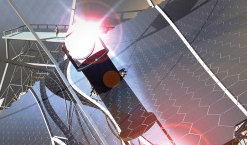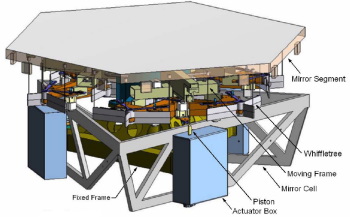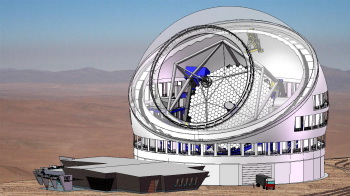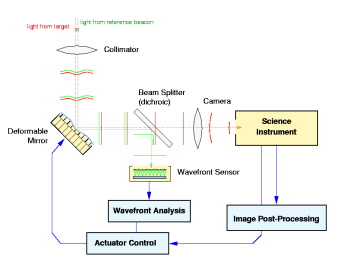
Size Matters
By Mike McLeod
General CAD design space explorationDesigning the Thirty Meter Telescope, the world's largest, poses significant challenges for Canadian and US astronomers and engineers but success may well reveal some of the universe's longest held secrets.

When Scottish mathematician James Gregory invented his revolutionary reflecting telescope, little could he have known that, 340 years later, his scientific descendants would begin work on The Thirty Meter Telescope (TMT), an instrument capable of answering some of the discipline’s oldest questions, such as how did galaxies, suns and planets first form and are we alone in the universe?
In 2003, the Association of Canadian Universities for Research in Astronomy, the California Institute of Technology, the University of California, and the US-based Association of Universities for Research in Astronomy, agreed to an equal partnership to build the world’s largest telescope. When completed in 2018 at a projected cost of approximately US$700 million, TMT will be as big as a football stadium, dwarfing the reigning 10-meter W.M. Keck Observatory’s collecting power by nine times and the Hubble Space Telescope by nearly 100 times.
The gain in light gathering ability, says Dr. Raymond Carlberg, astronomy and astrophysics professor at the University of Toronto and the Canadian scientific lead on the TMT project, will allow astronomers to see the most distant known objects in the universe. And, given the time it takes light to travel billions of miles across the cosmos, TMT will also peer back approximately 13 billion years to when matter first began to coalesce into stars and galaxies.
“There was a time in the universe where there were no stars and so TNT has the ability of going from today to back to the first stars,” he says. “That’s incredibly exciting.”
“The great thing about astronomy and astrophysics today is that we are genuinely solving problems for things we didn’t even know 10 years ago,” he adds. “For instance, 10 years ago we didn’t know that other stars had planets. Now we know that virtually all other stars have planets. The burning question is could those planets potentially support life. With a big telescope you can begin to ask those questions and get answers.”
Primary mirror
Using a modified version of the first reflecting telescope, TMT will be an aplanatic Ritchey-Chrétien telescope, a design that provides a large field of view compared to more conventional configurations. The 30-meter wide, parabolically-shaped primary mirror collects the faint light from deep space objects and concentrates it onto a much smaller ellipsoid secondary mirror. The secondary then reflects the light down toward a hole in the centre of the primary mirror where a flat and rotate-able tertiary mirror bounces the light sideways to one of the telescope’s large Nasmyth platforms. These platforms will hold the telescope’s various scientific instruments and its adaptive optics, a complex system that filters out thermal turbulence introduced by the Earth’s atmosphere.
While the overall principal may sound simple, designing TMT has posed significant challenges for the engineers and fabricators who are tasked with making the mammoth telescope a reality. Creating an extremely large telescope involves more than simply scaling technologies used in the Keck Telescope, which features many of the same design concepts that will make up TMT.
Keck’s 10-meter primary mirror, for instance, is made up of 36 smaller hexagonal mirror segments instead of one monolithic mirror. The reason for this is that monolithic mirrors larger than 8 meters begin to sag under their own weight as they slowly track across the sky. Each of the segments is individually controlled so that the segments work in unison to emulate one large mirror.
TMT, however, will have 492 mirror segments, each measuring approximately 1.4 meters across. Supported by a whiffle tree assembly, each segment will be controlled by a set of three voice coil-based force actuators to allow 3 degrees of freedom (piston, tip and tilt).

In addition, each mirror is equipped with edge sensors so a computer can determine how it is oriented relative to the mirrors around it. This positioning is done with such precision that the mirrors can be controlled to distances within fractions of a human hair. Since the segments sit only a few millimeters apart, the tricky bit is supporting the segments rigidly enough so that gravity doesn’t mash them together, says Nathan Loewen, a structural engineer for Port Coquitlam, BC-based Dynamic Structures, the engineering, fabrication and construction company charged with constructing TMT’s enclosure and support framework.
“That is controlled by the performance of the steel backing structure,” he says. “It needs to be very stiff so that, as you rotate to different pointing angles, you are not deflecting so much that those actuators have to compensate with huge strokes. The design is such that we have minimized those actuators strokes to about 1 mm.”
Given the sensitivity of the primary mirror, the telescope’s enclosure required a new design approach, says Loewen who is Dynamic Solution’s lead designer of TMT’s enclosure. “Everything becomes amplified as you go to larger sizes,” he says. “We knew that we couldn’t simply scale up existing designs or we would get performance that was totally unacceptable. So we really had to look at it from the ground up.”
Eye on the sky
For TMT, the Dynamic engineering team opted for a spherical “calotte” design, distinguished by it spherical shape and small eye-like aperture. To accommodate the telescope’s movement, the upper dome rotates about a vertical axis while the 45-degree offset “cap” swivels to allow the telescope to incline. Moving both in unison will give TMT the ability to track any part of the sky from straight up to approximately 25 degrees above the horizon.

The primary advantage of this design, says David Halliday, vice president and director of special projects for AMEC Dynamic Structures, is that it allows for the smallest possible aperture, limiting interference from external conditions.
“We have to build an enclosure that protects the telescope from wind and controls the encircling environment to within one degree of the anticipated night time temperature; if we drift off that, you can’t see anything,” says Halliday, whose department has built some of the world’s largest telescopes including W.M. Keck and the twin 8-meter Gemini Project telescopes.
“TMT will be so extremely sensitive that somebody once said to me that the heat from a mouse sitting in the corner could affect the image,” he adds. “That’s probably an exaggeration, but it gives an idea of how seriously we have to manage environmental conditions.”
Another advantage, says Loewen, is that the balanced nature of the structure also minimizes its mechanical requirements. In typical dome construction, massive shutters or doors have to be lifted or opened depending on how high a telescope is pointing above the horizon.
“It takes a huge amount of power to drive those things, which has implications on the kind of generators required, the annual power consumption and the complexity of the mechanical systems,” says Loewen. “With the calotte structure, the upper portion’s centre of gravity is balanced above its axis of rotation so the amount of power required to rotate it is minimal by comparison.”
Adaptive Optics
While TMT’s extremely large primary mirror may allow astronomers to delve farther into space, the images collected won’t be of much use if they are too blurry, says Jean-Pierre Véran, adaptive optics specialist for the Canadian Herzberg Institute of Astrophysics.

“Without adaptive optics, you are really losing much of the benefits of a big telescope; you see fainter objects, but you don’t get better details.” says Véran, whose Victoria, B.C.-based institute is internationally recognized as the leader in adaptive optics and telescope instrumentation.
In fact, he says, without adaptive optics, there isn’t much improvement in resolving power—the ability to clearly distinguish two closely grouped objects—beyond 1 meter. The problem, he says, stems from the fact that warm air and cold air don’t have the same optical index. While light from distant objects forms a perfect plane wave as it travels billions of kilometers on its way to Earth, it becomes distorted as it passes through Earth’s atmosphere.
“But you can undo this because it’s only the phase of the wave that is affected,” he says. “You accomplish the correction by bouncing the light wave onto a deformable mirror that is set to compensate for the distortion.”
“The deformable mirror is a fine sheet, like a glass membrane, which is coated on one side to reflect light,” he adds. “The other side is bonded to a number of actuators made of piezo material. You can locally deform the shape of the mirror by applying a voltage to these piezo actuators.”
As in the case of TMT’s segmented primary mirror, adaptive optics is a proven technology that has been integrated into a number of other large telescopes including the twin Gemini Telescopes. To accommodate the unprecedented size of TMT, however, Véran says the number of actuators will be increased from Gemini’s 177 to approximately 3,000 for TMT.
“That is a lot of actuators to control and update at speeds that are close to a kilohertz,” he says. “Every millisecond, you need to change each of the 3,000 actuators slightly—only a few microns in fact—so that the overall shape of the deformable mirror matches the effect of the atmosphere.”
Of course, for the deformable mirror to correctly compensate for atmospheric distortion, it needs some way of measuring the amount of turbulence at any given millisecond. To achieve this, a wavefront sensor measures the difference between what the telescope is receiving and the undistorted output of a known “reference star”.
After the light from the object under astronomical study and the reference star light are corrected by the deformable mirror, they are separated by a beam splitter. The reference star’s light is then directed to the wavefront sensor which, in turn, informs real-time computer hardware how to change the deformable mirror.
“It’s basically a closed-loop system,” Véran explains. “The sensor is measuring the residual of the correction and wants to be driven to zero which would be a perfect correction. If it measures non-zero, that means the correction was not perfect so it needs to update the shape of the deformable mirror. Of course, you have to allow one millisecond for the sensor to measure and then another to do the computation, but that’s okay because the turbulence is not changing so fast that two milliseconds matters very much.”
In past adaptive optics systems, the reference star has been a natural cosmic object but, Véran says, this limits observation to parts of the night sky that have bright enough natural reference stars. To get around this, TMT will use six high-powered lasers to create an artificial reference star.
“At about 90 km of altitude in our atmosphere, there is a layer that contains sodium atoms,” he says. “If you send some laser light to this altitude, it is going to excite these sodium atoms and cause them to omit another photon that will return to you. This results in a spot of light at 90 km of altitude. That spot allows you to point the telescope anywhere you want and so the range of your system is almost perfect.”
In April 2009, the TMT’s adaptive optics (AO) passed its initial testing. In addition to the deformable mirror, the AO system includes a Tip-Tilt stage that assists in the image correction. The deformable mirror—which weights 40 kilograms (88 pounds)—has to change its orientation at least 20 times each second. The accuracy of these adjustments must be very precise, corresponding roughly to the angle that a star appears to move across the sky in about one-ten-thousandth of a second.
From a Canadian point of view, the biggest potential challenge facing the TMT project has nothing with its segmented mirrors, structural design or adaptive optics system and has more to do with its projected $700 million+ price tag.
Pre-construction of TMT is scheduled for 2010, by which time the partners will have to produce their share of the construction and facility maintenance costs or lose their share of observing time. AMEC’s Halliday says it has taken years to assemble TMT’s talented team; failing to fund the project now would relegate Canadian astronomers to the fringe of cosmology.
“It is really important that this US/Canada partnership get on with it because there is no doubt that, when this telescope gets on the sky, it will make discoveries that are going to be absolutely staggering.”
www.tmt.org
www.empireds.com
www.hia-iha.nrc-cnrc.gc.ca
Originally published in Design Engineering, June 2006, with updates
